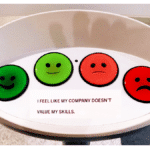Estimated reading time: 3 minutes
I know that organizations really, really, really want employees to return to onsite work. I’ve seen articles – and I’m sure you have too – about CEOs threatening to layoff or fire employees who don’t return to onsite work. I’ve also seen articles about organizations that are turning returning to the office (aka RTO) into something celebratory, with food trucks, concerts, etc.
I’m not sure if threatening employees is the way to get them excited about being onsite again. But I’m also not sure that a food truck is either. No offense to food trucks. There’s a Halo Donut truck here in Gainesville that I’m dying to check out.
But at this year’s Future of Everything conference hosted by The Wall Street Journal (WSJ), I learned about a new concept called the “Third Space”, which is being described as a place where we can blend work and wellness. During the event, WSJ shared a short video about it titled “The Office of the Future Might Not Be an Office”. The video does a nice job of giving you a visual.
After the event, I was still intrigued about Third Spaces, so I found an article on a blog called Third Space Network titled “Defining the Third Space”. This article defines Third Spaces as places that are not home and not work. Think museums, sports complexes, nightclubs, etc.
My takeaway was that maybe Third Spaces can be where organizations and employees can reach common ground. Hear me out:
Companies want employees to gather. Their case for returning to the office is teamwork, camaraderie, collaboration, etc. Honestly, there’s some truth in it. Organizations might benefit from interactions to generate creativity and innovation. Employees have said how much they miss those things as well.
Employees want productivity. And what I mean by that is they want an end to wasteful meetings that keep them from leaving the office on-time and spending time with family and friends. Remote work can provide a sanctuary from wasteful practices. It can help employees stay focused.
So, what if organizations create Third Spaces that accomplish both? They bring people together (what companies want) and provide the focus to get stuff done (which is what employees want).
Maybe initially Third Spaces could be designated for work teams and, based on the results, expanded to other groups. I could see employees looking forward to spending time in a Third Space. And I think the experience would last longer than a pizza party. Let’s be real, that would have to be some phantasmic pizza.
The Third Space can also be an option for organizations that are committed to allowing employees work remotely. There will still be times when you want the team to get together. And it’s possible there’s not enough onsite space to host everyone. A Third Space could be a perfect choice.
Third Spaces allow organizations to use their creativity. A Third Space can be a coffee shop, restaurant, or even a place of worship. Companies might have businesses they would like to support but not sure how to do it. And they don’t want to take a group of employees to a local bar (nor do employees want to go). For organizations wanting to help the economy and their local businesses, a Third Space could provide a benefit and give employees an interesting, fun, and most of all, productive experience.
I don’t have all the answers here, but I do think there’s room to explore. And for organizations looking for ways to create employee gatherings, this might be a way to start.
Image captured by Sharlyn Lauby while exploring the streets of Key West, FL
17







